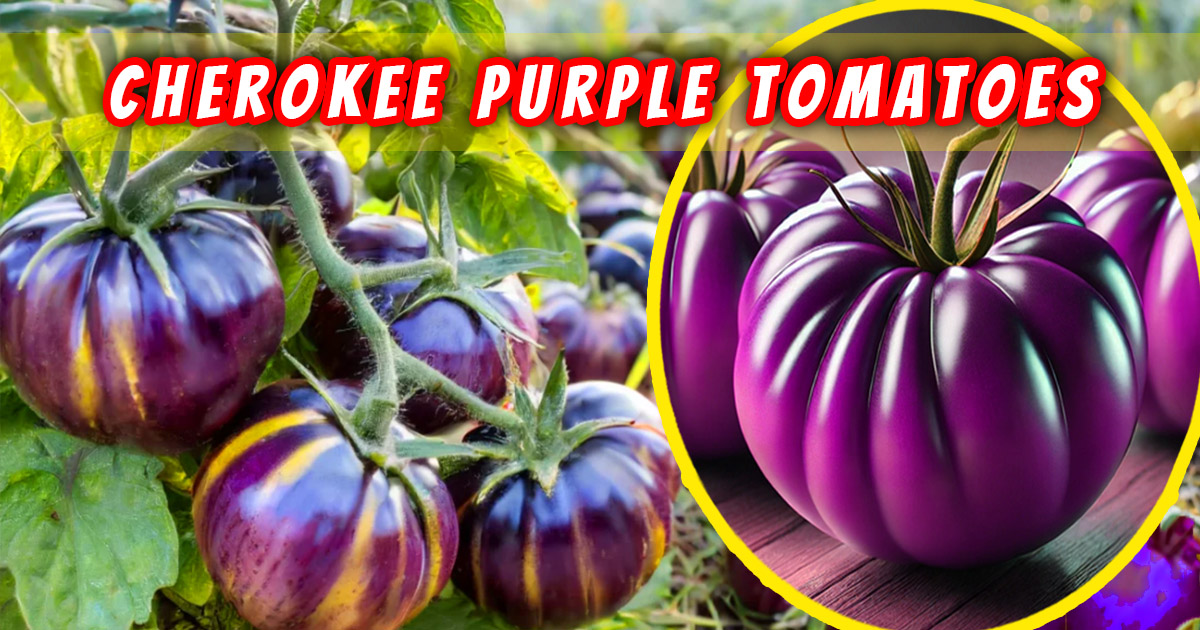Introduction to Cherokee Purple Tomato
The Cherokee Purple Tomato is one of the most beloved heirloom tomato varieties, known for its rich flavor and unique purple-red hue. This variety dates back over 100 years and has a storied history, rumored to have originated from seeds passed down by the Cherokee tribe. Its distinctive look, coupled with a flavor that balances sweetness and acidity, makes it a favorite for gardeners and chefs alike.
In this guide, we’ll explore everything you need to know about growing Cherokee Purple Tomatoes, their health benefits, and why they are a must-have in your garden.
Why Choose Cherokee Purple Tomato for Your Garden?
Cherokee Purple Tomatoes offer a variety of benefits for home gardeners. Aside from their stunning appearance, they are highly prized for their unique, smoky-sweet flavor and dense, meaty texture. This makes them perfect for slicing into salads, sandwiches, and for fresh consumption.
But the appeal of this tomato goes beyond its flavor. As a heirloom variety, Cherokee Purple Tomatoes are not hybridized, meaning they have been passed down through generations without cross-breeding. This preserves their original genetic makeup, giving them deep, authentic flavors that many newer varieties lack. Additionally, they are open-pollinated, which means you can save the seeds and grow your own next season.
How to Grow Cherokee Purple Tomato: A Step-by-Step Guide
1. Best Planting Practices
Cherokee Purple Tomatoes thrive in warm, sunny conditions. They are an indeterminate variety, meaning they will continue to grow and produce fruit throughout the growing season. Start the seeds indoors about 6-8 weeks before the last frost, and transplant them outside once nighttime temperatures stay above 55°F (13°C).
2. Optimal Growing Conditions
These tomatoes require full sun (at least 6-8 hours of direct sunlight per day) and need to be planted in well-drained soil. Ensure the soil is rich in organic matter and has a pH level of 6.0-6.8. You can amend the soil with compost or organic fertilizer to enhance its quality.
Cherokee Purple Tomato Planting and Care Tips
1. Watering and Pruning
Water your Cherokee Purple Tomato plants deeply and regularly, keeping the soil evenly moist. A soaker hose is ideal for this as it delivers water directly to the roots. Mulching can help retain moisture and prevent weed growth.
Pruning is essential for indeterminate varieties like Cherokee Purple. Remove any suckers (the small shoots growing between the main stem and branches) to allow better air circulation and reduce the risk of diseases.
2. Support Structures
Since Cherokee Purple Tomatoes grow tall and heavy with fruit, you’ll need to provide support. Stakes or tomato cages work well to keep the plants upright and prevent the fruit from resting on the ground.
When and How to Harvest Cherokee Purple Tomatoes
They are ready to harvest when they reach a deep reddish-purple color with greenish shoulders. They should feel slightly soft to the touch but not mushy. Typically, it takes around 80-90 days from transplanting to harvest.
Use garden shears or scissors to gently cut the fruit from the vine, ensuring not to damage the plant. Avoid pulling the tomatoes directly by hand, as this can harm the plant and reduce future yields.
Flavor and Culinary Uses
Cherokee Purple Tomatoes are renowned for their complex, robust flavor. Their earthy-sweet taste with a hint of smokiness makes them a favorite for fresh eating. You can slice them for sandwiches, salads, or use them in caprese salads paired with mozzarella and basil.
Here are some culinary uses for Cherokee Purple Tomatoes:
- Fresh salsas
- Grilled or roasted as a side dish
- In bruschetta with garlic and olive oil
- As a topping for pizzas or flatbreads
- In pasta sauces for a rich, hearty flavor
Health Benefits of Cherokee Purple Tomatoes
They are not just delicious—they are packed with nutritional benefits. They are rich in vitamins A and C, both of which support immune health and skin care. Additionally, if you are interested in unique plants like the Cherokee Purple Tomato, be sure to check out Purple Watermelon and Purple Plants for more fascinating additions to your garden. They also contain a significant amount of lycopene, a powerful antioxidant known for its role in reducing the risk of heart disease and certain cancers.
Other benefits include:
- Low in calories, making them great for weight management
- A good source of potassium, which helps maintain healthy blood pressure
- High in fiber, aiding digestion
Common Problems When Growing Cherokee Purple Tomatoes (And How to Solve Them)
1. Cracking
Cherokee Purple Tomatoes are prone to cracking, especially if they experience irregular watering. To avoid this, keep the soil evenly moist and avoid overwatering after dry spells.
2. Pests
Common tomato pests include aphids, hornworms, and whiteflies. You can use organic insecticides or introduce beneficial insects like ladybugs to keep the pest population under control.
3. Diseases
They are susceptible to fungal diseases like blight and powdery mildew. Prevent this by providing good air circulation, mulching, and avoiding overhead watering. If needed, apply organic fungicides as a preventative measure.
Cherokee Purple Tomato Companion Plants
Companion planting can help improve your Cherokee Purple Tomato yields and protect them from pests. Here are some excellent companion plants:
- Basil: Enhances tomato flavor and repels pests
- Marigold: Deters nematodes and other harmful insects
- Carrots: Help aerate the soil around tomato roots
- Garlic and onions: Natural pest repellents By pairing your tomatoes with these plants, you’ll create a more resilient garden ecosystem.
How to Start Cherokee Purple Tomato Seeds Indoors
Starting Cherokee Purple Tomato seeds indoors can give you a head start on the growing season, especially if you live in a region with a shorter summer. Here’s a simple guide to get you started:
1. Timing Is Key
Begin by planting seeds indoors about 6-8 weeks before the last expected frost in your area. This gives the seedlings enough time to develop strong roots before being transplanted outdoors.
2. Seed Starting Mix
Use a light, well-draining seed starting mix, which is different from garden soil. This mix helps the seeds germinate quickly and prevents fungal diseases that can affect young plants.
3. Light and Temperature Requirements
Cherokee Purple Tomato seeds require warmth and light to germinate. Place the seed trays in a location that receives plenty of sunlight, or use a grow light to supplement. The ideal temperature for germination is between 70°F to 80°F (21°C to 27°C). Using a heat mat can help maintain consistent soil warmth.
4. Watering Seedlings
Keep the soil moist but not soggy. Watering from the bottom by placing the seed tray in a shallow container of water can help avoid disturbing the young seedlings and ensure even moisture distribution.
Once the seedlings have grown their first true leaves, they’re ready to be transplanted into larger containers or directly into your garden after hardening off.
For additional tomato care tips, you can visit the University of Florida’s gardening guide here.
Best Fertilizers for Cherokee Purple Tomatoes
To grow strong, productive Cherokee Purple Tomato plants, providing the right nutrients at the right time is crucial. Here are some of the best types of fertilizers to use:
1. Organic Compost
Using organic compost as a soil amendment before planting adds essential nutrients and improves soil structure. Compost releases nutrients slowly, ensuring a steady supply of food for the tomato plants throughout the growing season.
2. Balanced Fertilizers
A balanced fertilizer with equal amounts of nitrogen (N), phosphorus (P), and potassium (K) is ideal during the early stages of growth. A ratio like 10-10-10 or 5-5-5 works well to encourage both leafy growth and root development.
3. Phosphorus-Rich Fertilizer
As the plants begin to bloom and set fruit, switch to a fertilizer that’s rich in phosphorus, which promotes healthy fruit development. Look for fertilizers with a higher middle number, such as 5-10-5.
4. Fish Emulsion or Seaweed Extract
For organic growers, fish emulsion or seaweed extract can be used as a liquid fertilizer. These natural fertilizers are rich in micronutrients and help boost plant resilience.
Remember not to over-fertilize, as too much nitrogen can result in lush foliage but fewer fruits.
Conclusion: Why Cherokee Purple Tomato is Worth Growing
In conclusion, the Cherokee Purple Tomato is an excellent choice for any home gardener. Its unique flavor, historical significance, and nutritional benefits make it a standout variety. With proper care, you can enjoy a bountiful harvest of delicious tomatoes all season long. Whether you’re a seasoned gardener or a beginner, Cherokee Purple Tomatoes are a rewarding addition to your garden.
FAQs About Cherokee Purple Tomatoes
1. How long does it take for Cherokee Purple Tomatoes to ripen?
Cherokee Purple Tomatoes typically take 80-90 days from transplanting to harvest.
2. Are Cherokee Purple Tomatoes disease-resistant?
While they are hardy, Cherokee Purple Tomatoes can be susceptible to common tomato diseases like blight and powdery mildew. Proper care and preventive measures can help reduce these risks.
3. What makes Cherokee Purple Tomatoes unique?
Their deep, rich flavor with smoky, sweet undertones and their purple-red hue make them stand out among other tomato varieties.
4. Can I grow Cherokee Purple Tomatoes in containers?
Yes, Cherokee Purple Tomatoes can be grown in large containers. Just make sure the container is at least 18 inches deep and provides proper drainage.
5. What are the best soil conditions for growing Cherokee Purple Tomatoes?
Cherokee Purple Tomatoes thrive in well-drained, nutrient-rich soil with a pH of 6.0-6.8.
6. Can I save seeds from Cherokee Purple Tomatoes?
Yes, Cherokee Purple Tomatoes are open-pollinated, so you can save seeds from your harvest and grow them again next season.
To explore more gardening tips visit here.

Joseph Bush is a seasoned writer and researcher with over 7 years of experience covering a wide range of general topics, from lifestyle and technology to business and current events. He is dedicated to producing fact-checked, reader-friendly content that informs, engages, and empowers readers.
Throughout his career, Joseph has followed strict editorial guidelines, relied on reputable sources, and ensured every article meets the highest standards of accuracy and clarity. His expertise spans multiple fields, allowing him to explain complex topics in a way that’s easy to understand.
Passionate about continuous learning, Joseph stays updated on industry trends and best practices to deliver trustworthy, well-rounded insights. Readers can rely on his work for its credibility, depth, and real-world relevance.




